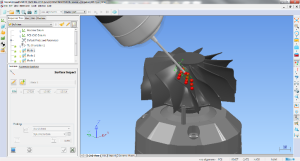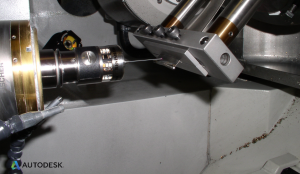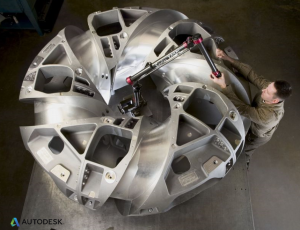Inspection for Additive Manufacturing
Composite materials are increasingly used to create products with significant advantages over traditional alternatives, but simply replicating an existing design in a new material squanders the potential. Composite materials are anisotropic, meaning that the properties are not the same in all directions and axes, and this provides enormous flexibility to optimize the design. Material properties can be precisely controlled alongside more conventional design parameters, but this requires complex, customized fabrication processes. The material-forming processes typically introduce some degree of shape distortion, creating additional hurdles to the goal of manufacturing accurate, consistent parts.
Highly skilled workers are able to minimize and manage variability, but the resulting labor-intensive processes are expensive and difficult to scale up. Automation design and manufacturing solutions like the ones offered by Autodesk require holistic approaches to quality control, with intelligent application of measurement throughout the process. Even specifying accuracy and tolerance requirements becomes more complex. In trimming and drilling operations, for example, the overriding consideration is the ability to conform very closely to the localized surface.
On-machine verification is one form of automated, in-process measurement used to quantify, adapt, and improve manufacturing operations.
Adaptive manufacturing compensates for variation that has already occurred by using measurement results to adjust subsequent machining operations. The simplest example is probably adaptive countersinking, in which depth is controlled precisely by taking a localized measurement of the surface and adjusting the cutting operation to suit.
Real, lasting improvement (i.e., reducing or preventing variation) is often the next step, but this is an ambitious goal that requires deep understanding of the process. The maxim that “You cannot manage what you cannot measure” has never been truer.
Additive manufacturing comes of age—or does it?
Additive manufacturing (also known as 3D printing) is another interesting technology with great potential for making better products, but so far it has failed to deliver on the hype because the complexity of the process has been underestimated.
There are two major differences between additive manufacturing and other forms of material forming. Complexity comes “for free,” meaning that for a given volume of material, it is almost as easy to make a highly complex shape as it is to make a simple sphere or cube. The other consideration is that it’s less scalable than other processes—in other words, the time and cost is directly proportional to the volume of the material. Doubling the size of a cube requires eight times as much material, and the printing process also lasts eight times as long.
Technology will continue to improve, but exploiting additive manufacturing will require different and more complex designs. At this time, additive manufacturing also has much more variation in the process than conventional machining or subtractive processes.
Although 3D printing equipment is achieving ever-higher resolution, this doesn’t necessarily result in improved accuracy. Resolution, which is often expressed as dots per inch or as a function of layer thickness, is a good measure of the capacity to create fine detail. This refers to the smallest measurement that the machine can reproduce, but resolution doesn’t guarantee overall system accuracy because the individual dots and layers aren’t perfectly sized and positioned. A completed product is built from vast numbers of dots or layers, and tiny inaccuracies quickly stack up.
In fact, at the present time 3D printing is significantly less accurate than the best traditional production machining processes. This poses real challenges to producing accurate, consistent parts. Metrology allows us to measure and compensate for variation and is fundamental to controlling it. It turns out that additive manufacturing works best when combined with conventional subtractive machining, which takes advantage of the best aspects of each and introduces a whole new set of measurement and quality control challenges, ranging from final inspection to adaptive techniques and process control.
Changes and challenges
The evolution of technology constantly poses new challenges for manufacturing, but it also helps point the way toward solutions. Moore’s Law describes the exponential growth of computing power during the last half-century but is an observation and projection rather than a fundamental physical law. It has arguably become a self-fulfilling prophecy, however, by setting expectations for long-term planning and defining research and development goals. There is conjecture about how long this can be sustained into the future—predictions range from 10 to 600 years—and there is even philosophical debate about whether the upper limit is constrained by natural laws or human nature. The growth of cloud computing ensures that computing power will continue to be available and affordable, and also introduces new possibilities for collaboration and supply chain integration.
Design for manufacturability describes the process of designing a product to facilitate the manufacturing process, allowing faster new-product launches and reducing manufacturing costs. Good design also takes inspection into account, and measurement requirements can be specified during the design process and included as part of the digital model. This allows inspection requirements to be communicated throughout the supply chain, together with the rest of the design intent.
Increasing product differentiation and faster new-product integration becomes possible by flexibly configuring an interconnected system of suppliers and subcontractors, but process improvement must address the system as a whole. There is less room for uncertainty, and areas of risk must be quantified and better understood. More thorough quality audits are one part of the solution, and the integration of metrology into both the manufacturing process and the final quality assurance protocols can turn many of these uncertainties into qualified data. Measurement is an invaluable resource for continuous process control, but we need to appreciate that improvements come from improving the system as a whole, rather than optimizing the performance of a single element at the expense of another.
Complicating all these factors is the very real issue of the skills gap, caused by the retirement of a graying workforce and the resulting shortage of practical metrology skills. Investment of time, resources, and money are necessary to secure the future of this critically important sector. Technology is of course a necessary component, and will likely shape the nature and the balance of the skills and expertise that will be required in the future—but it in and of itself isn’t sufficient. The Coordinate Metrology Society is one of the bodies attempting to increase the general standards of skills and knowledge within industry. Sustaining a competitive edge in the digital manufacturing age requires not only investment and attention, but also an unflinching commitment to continuous improvement of the system as a whole.
The adage that “You can expect what you inspect” may not be the whole truth, but it is still a fundamental principle of the world of design and manufacturing, past, present, and future.
For more information, contact Autodesk or visit us at MetromeetAuthor: Phil Hewitt (Product Manager Manufacturing and Inspection)






Add comment
Connect with: Log in
There are no comments